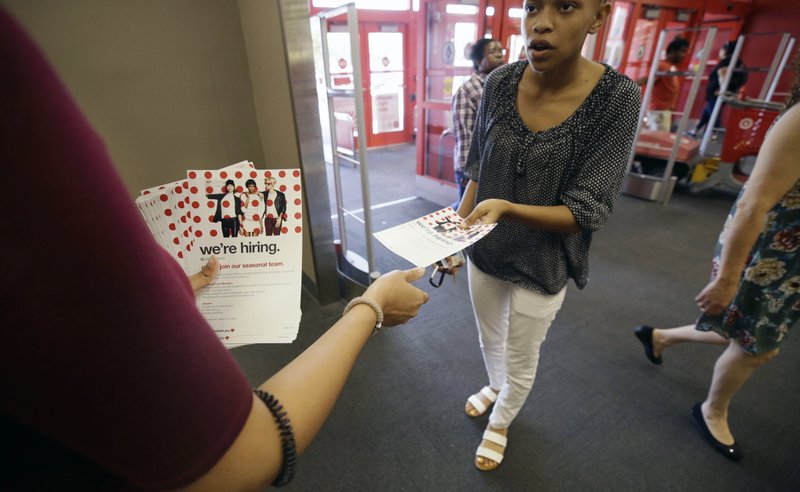WASHINGTON -- U.S. employers added 261,000 jobs in October in a bounce back from the September hurricanes.
The unemployment rate fell to 4.1 percent, the lowest in nearly 17 years, from 4.2 percent in September, the Labor Department said Friday. But the drop in the rate occurred mostly because many people stopped looking for work and so were no longer counted as unemployed.
The unemployment figure has fallen steadily this year, from 4.8 percent in January.
October's burst of hiring largely reflects a rebound from the hurricanes that temporarily depressed job gains in September. But it also shows that for all their fury, the storms didn't knock the economy or the job market off course. Over the past three months, job growth has averaged 162,000, similar to the pace of hiring before the hurricanes.
"Hiring got a boost from the post-hurricane rebound, but the underlying trend remained steady," said Jed Kolko, chief economist at Indeed, a job-search website.
The proportion of adults who are either working or looking for work fell last month to 62.7 percent, slightly lower than a year ago. That drop suggests that there aren't many people on the sidelines who want jobs.
"The bigger picture here is that the labor market's fine," said Brett Ryan, an economist at Deutsche Bank in New York.
Despite a shortfall of workers, average hourly pay rose just 2.4 percent from a year ago, nearly one-half percentage point lower than September's annual gain. That figure might have been distorted by the hurricanes: Many lower-paid workers at restaurants and bars returned to work last month, and their influx could have depressed overall pay.
Still, the figure illustrates a chronic shortcoming of the economy: Even as the unemployment rate has reached a nearly two-decade low, employers haven't yet been forced to offer significantly higher wages to attract or retain workers.
"It's certainly trending the right way, but it's surely still unexciting -- even unacceptable -- wage growth at this point," said Dan North, chief economist at Euler Hermes North America.
The government also revised up its estimate of the job total for the previous two months. In August, employers added 208,000, up from 169,000. They added just 18,000 in September as thousands of businesses were forced to close. But that figure was revised higher from a previous estimate that showed a loss of 33,000.
With September's jobs figure back in the positive column, the economy has now added jobs for 85 straight months, a record streak.
The biggest swing in the past two months occurred among restaurants and bars, which shed 98,000 jobs in September. That reflected shutdowns in Texas and Florida after hurricanes Harvey and Irma. Yet restaurants and bars regained 89,000 jobs last month.
Manufacturers added 24,000 jobs. A category that includes mostly higher-paying professional jobs, such as accountants and engineers, added 50,000. Retailers shed 8,300.
Even with the economy in its ninth year of recovery from a recession, hiring remains solid and growth is healthy. For the first time since the downturn, the global economy is broadly improving, with all major advanced economies expanding at the same time.
A report Friday from the Institute for Supply Management said U.S. services companies in October grew at the best rate in more than a dozen years.
The Institute for Supply Management's services index rose last month to 60.1 from 59.8 in September. Any reading above 50 signals expansion. The October reading was the biggest since August 2005. The services sector has reported growth for 94 consecutive months.
The strength in the services sector is emblematic of a U.S. economy that looks increasingly healthy. Economic growth climbed above an annualized level of 3 percent for the past two quarters -- and appears to be solid for the final three months of 2017.
There's no question that the U.S. economy appears to be stronger than it was a year ago, said Anthony Nieves, chairman of the Institute for Supply Management's nonmanufacturing business survey committee.
"The question that remains is how sustainable is this," Nieves said.
Consumer spending, the dominant driver of economic growth in recent years, has stayed strong. But consumers are no longer alone in driving the economy forward. Stronger global growth has led to higher demand for U.S. goods and services in recent months, aiding the manufacturing sector and increasing exports.
"It's finally feeling like the economy is starting to fire on multiple cylinders rather than relying solely on consumers," said Ryan, the Deutsche Bank economist.
Information for this article was contributed by Christopher S. Rugaber and Josh Boak of The Associated Press; by Ben Casselman of The New York Times; and by Don Lee of Tribune News Service.
A Section on 11/04/2017

